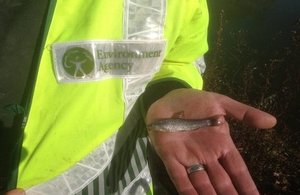Environment Agency winning the war on destructive invasive fish
The Environment Agency has moved one step closer to winning its war against a tiny yet destructive invasive fish

Topmouth gudgeon impact native fish by outcompeting them for food and habitat
The Environment Agency has moved one step closer to winning its war against a destructive invasive fish which has been wreaking havoc in the country’s lakes and ponds. Topmouth gudgeon outcompete native fish for food and habitat, and spread disease.
At their peak, a decade ago, topmouth gudgeon had been found widely spread across the UK at 23 locations. But after today’s (17 February) operation, and through the Environment Agency’s targeted removal, there are now just three remaining sites in England.
This is not the first time that the Environment Agency has led the complete removal of an invasive species. The fathead minnow was eliminated in 2008 followed by the black bullhead catfish last year.
Smaller than an average thumb, what topmouth gudgeon (pseudorasbora parva) lack in size they make up for with quantity. They breed up to four times a year and as a result can form vast populations.
Their sheer numbers mean that they impact native fish by outcompeting them for food and habitat. This in turn means fewer invertebrates available to other fish and wildlife and upsets the natural balance of a lake or pond. Topmouth gudgeon also eat the eggs of other fish and carry a parasite.
Native to Asia, it is thought that they were introduced to Britain in the 1980s from mainland Europe and potentially spread through fish farm movements and the ornamental fish trade.
Today expert fisheries officers, kitted out in specialist protective gear, were on-site for this latest operation at three ponds in Hackney, north London.
Sarah Chare, head of fisheries at the Environment Agency, said:
Invasive species pose a serious threat to our native wildlife and cost the UK economy a massive £1.8 billion a year. Topmouth gudgeon are on our hit list of the UK’s most damaging invasive species and despite only being tiny have devastating effects on fisheries and angling.
While Britain’s rivers are the healthiest for more than 20 years, rivers and ponds that harbour non-native species can have their water quality and ecology affected and could fall short of tough EU targets.
It is not certain how the topmouth gudgeon first found their way to the ponds in Hackney but experts believe it is likely that they were dumped illegally. The Environment Agency is urging people who own fish that the apparently harmless action of releasing unwanted fish into a local pond can have disastrous long-term effects on the environment and other animals within it.
To ensure the continued success of this work, the Environment Agency is asking members of the public to report any sightings of topmouth gudgeon, or other invasive fish species to its incident hotline on 03708 506506, via email at: email:non-natives@environment-agency.gov.uk or via the AquaInvaders app downloadable here.
Everyone can do their bit to help prevent the spread of invasive species by following the principles of the ‘Be Plantwise’ campaign and not dumping aquatic plants in the wild and always disposing of old plants and pond material responsibly, and by composting or using a green waste bin. By following the tips of the ‘Check, Clean, Dry’ campaign, anglers, boaters and canoeists can help prevent the spread of invasive species between waterways.
The ponds are owned by Hackney Council. The reinstatement and management of the ponds following eradication will be decided by Hackney Council.